Effie Hegermann-Lindencrone was born in Hillerød, Denmark, on August 27, 1860. This photo of her was taken in July 1879, a month before her nineteenth birthday:
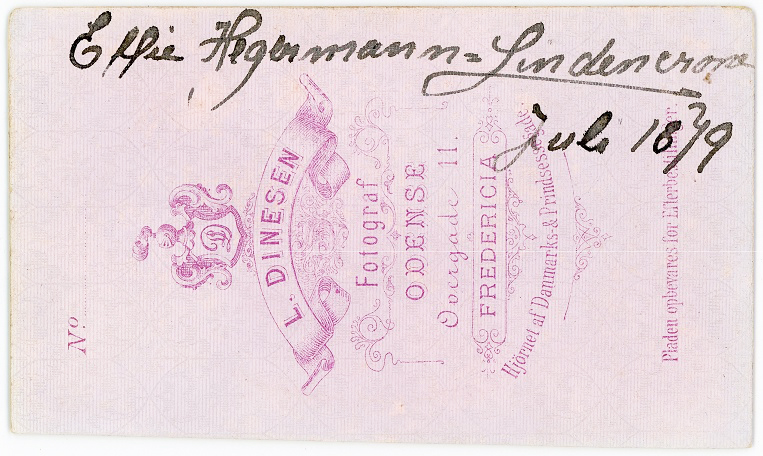
The carte-de-visite portrait was made at one of the two studios owned by photographer Lars Dinesen, either in Odense or in Fredericia:

A year after the photo was taken, Effie enrolled at the Drawing School for Women (Tegneskolen for Kvinder), where she would remain for five years (1880-1885). While there, she met Fanny Garde (1855-1928), a young teacher who had been a member of the school’s first entering class of students in 1876. In 1886, Effie and Fanny were invited to work at the Bing & Grøndahl Porcelain Factory, where they would share a studio. The two women would continue to work together at Bing & Grøndahl, and eventually live together, until Fanny’s death in 1928.
The Danish auction house Bruun Rasmussen wrote the following in 2014 (edited slightly for clarity):
Effie Hegermann-Lindencrone’s and Fanny Garde’s chosen motifs are those of naturalistic flowers, plants, insects and especially seaweed. The porcelain is artistically modelled in relief, making the effects of light and shadow interact beautifully with the underglaze decoration. There is no doubt that the two artists’ porcelain creations for Bing & Grøndahl are among the finest Danish examples of skønvirke-porcelain.
(Skønvirke is the Danish form of Jugendstil or Art Nouveau.)
Effie Hegermann-Lindencrone (1860-1945) is now considered by many to be the most talented and successful porcelain artist of the Art Nouveau period in Denmark. Her work can be found in numerous museum collections, including the V&A. Her Covered Vase (1916) at the Art Institute of Chicago is particularly striking.
Most of the information available online about Effie is in Danish. However, I found one website in English, A Private Collection of Danish Porcelain, which features photographs of a number of her unique creations. I contacted the website’s owner, who lives in Germany. For privacy reasons he prefers to remain anonymous online, but he kindly responded to my email and granted permission to reproduce some of the photos from his website here. I picked three vases and asked if he would consider writing a few words about them for this post. Below are his photos of the vases, in order of their creation, and his thoughts about them.
Fern and Grasshopper Vase (1906)
“Effie and Fanny created more than 3000 unique pieces numbered in their own system. This fern vase with grasshoppers at the upper rim is one of those nice examples of the Danish Art Nouveau. The fern is so precisely painted in each detail and color variation. The grasshoppers are carved into the hard porcelain and the vase is slightly pierced, giving the observer the impression of a plastic animal. The vase was created in 1906, it is 30 cm high.”
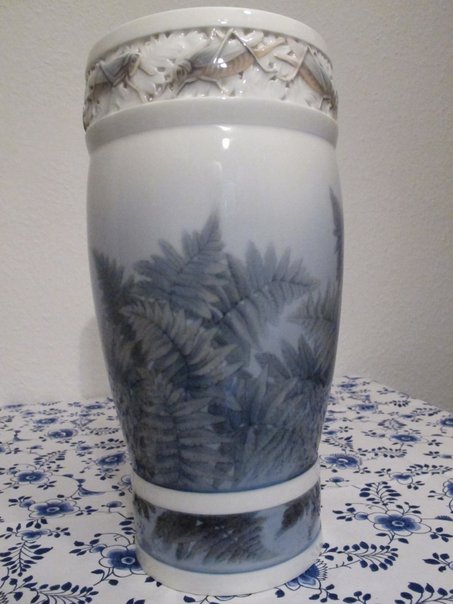
Marine Life Vase (1916)
“Another example of her skill is this Marine Life Vase that Effie created in 1916. While the rest of the world drowned in chaos, Effie executed this delicate piece of the later Art Nouveau. Looking closely at the vase you will be able to recognize crabs, mussels and fish finding their way though the waving seaweed. The complete vase scene is carved and gives a plastic picture of the scene that gets dynamic the longer you look at it. Natural and intensive colors characterize the decoration.”
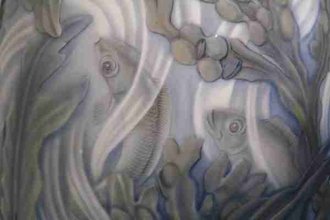


Seaweed Vase (1924)
“A masterpiece of her works is certainly the large seaweed vase. Effie was already 64 years old when she executed this vase. The elegant shape of the vase directs the view of the observer to the sea anemones depicted in front of seaweed. The vase is strongly carved and pierced at the neck. Again this technique enables a dynamic impression of the underwater scenery. Very precise choice and execution of the colors underline this extraordinary work, which was owned by an important family in Denmark for a long time. The sister piece of this vase is located at the CLAY Museum in Denmark. A stunning piece of artwork in porcelain, 64 cm high.”
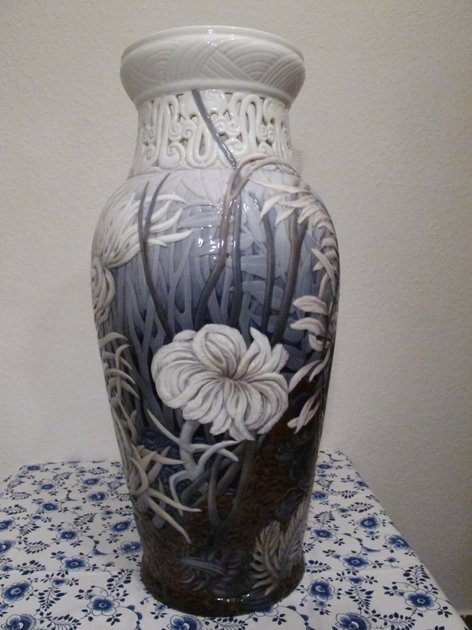
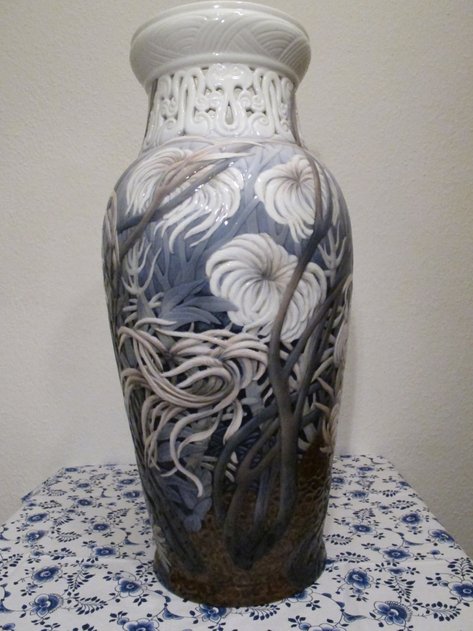
If you’d like to see more of Effie Hegermann-Lindencrone’s work, an image search online will bring up plenty of results. You probably won’t see another picture of her, though. I haven’t managed to find one. This carte-de-visite came from an old album of Danish photographs in England. Were other photos of her lost or destroyed? Do any exist in museum archives? If they do, I hope to see them someday.

Sources:
A Private Collection of Danish Porcelain
Dansk Kvindebiografisk Leksikon (Danish text, no photos)
Kunstindeks Danmark & Weilbachs Kunstnerleksikon (Danish text, no photos)
Wikipedia (Danish text, no photos, but Wikimedia Commons has 4 photos of art porcelain)
Bruun Rasmussen Kunstauktioner
History of Photography / fotohistorie.com (Danish text with numerous photos taken by Lars Dinesen)
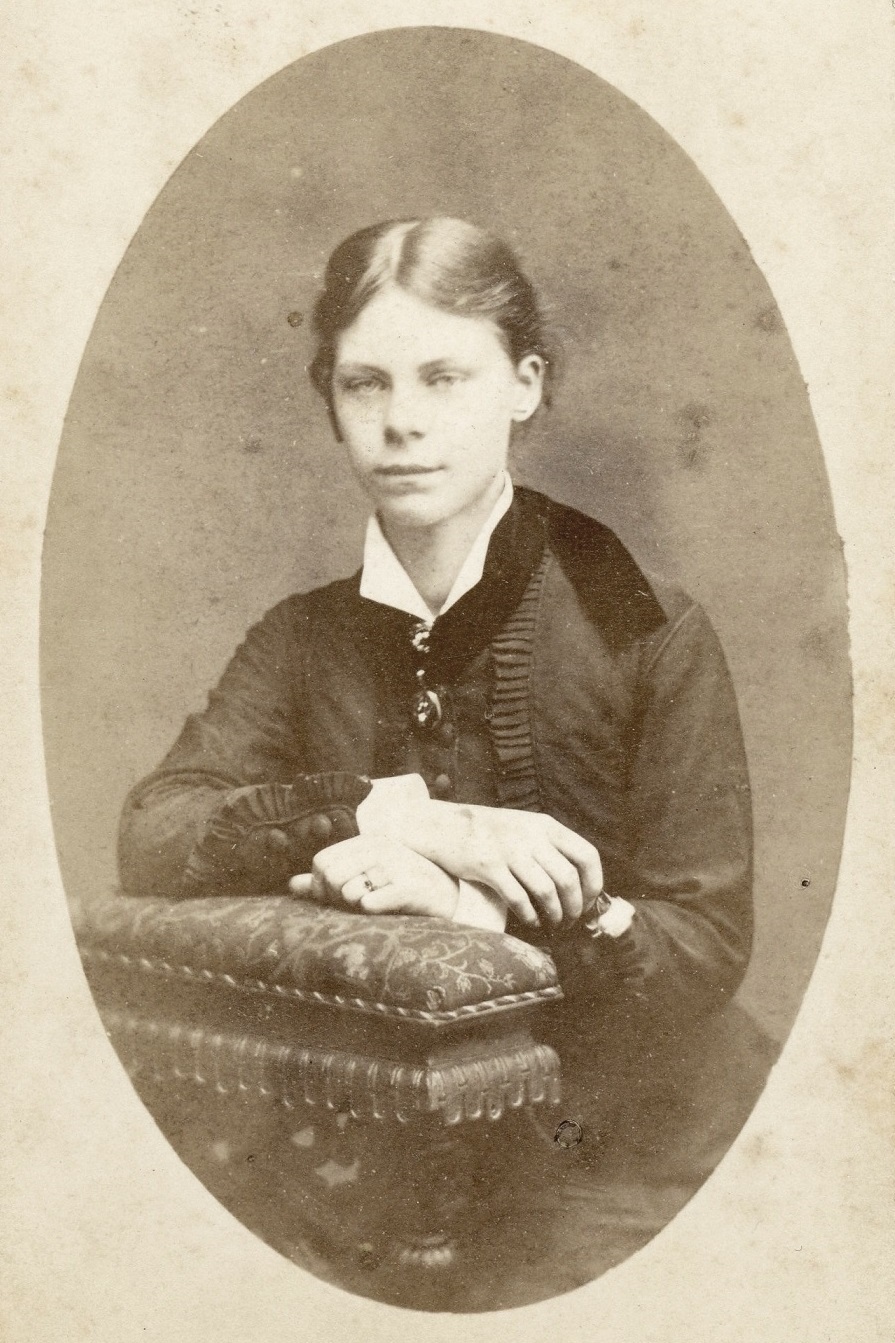












What beautiful creations! The textures seem to add a sculpture like quality.
LikeLiked by 3 people
Yes, I think that’s what my contributor meant when he used the word ‘plastic’ in reference to the grasshoppers and the marine scene. I looked it up and found this explanation on a German website: https://academy-of-fine-art.com/2018/06/sculpture-plastic-arts-plaster-cast-what-is-the-difference/
LikeLiked by 1 person
Thank you!!
LikeLiked by 1 person
It is enlivening to see this from Denmark: so rarely do we see anything from any part of Scandinavia in an exhibition with the exception of one or two very famous artists.
I suppose it is a matter of our joint history and the conservative nature of their societies that things were kept in the family and in their own museums!
Thanks very much! Sarah
LikeLiked by 3 people
If I ever make it to Denmark, I’ll allow several weeks just to visit museums! Other than the Skagen artists, we rarely get to see Danish art in museums here in the States.
LikeLiked by 1 person
Effie’s work is spectacular! It would take me forever to draw those designs on paper. And she did it on porcelain! Thank you for posting all the links. How nice of the collector to share photos of her creations and information about them.
LikeLiked by 3 people
It would be interesting to learn more about her process. I don’t have a very good understanding of it. Strangely, there isn’t much information about her online. I hope that changes in the future. Thanks, Morgaine!
LikeLike
This is fascinating. My mother collected B&G Christmas plates for a couple of decades. By the 1960s, they had changed somewhat, both thematically and artistically, but they certainly were among the most desired of the Christmas collectibles.
I wondered when the plates’ production began, and found an example of one from their first year: 1895. It was titled “Behind the Frozen Window,” and what’s most interesting is that it bears some slight resemblance to the work done by Effie Hegermann-Lindencrone: particularly the frost shown in relief. I really enjoyed seeing her other work; it’s spectacular.
LikeLiked by 3 people
In the 1890s, Fanny Garde designed the Seagull dinnerware series, which “became known as the ‘National Service of Denmark’ in the 1950s when it was found in one tenth of all Danish households.” (https://en.wikipedia.org/wiki/Bing_%26_Gr%C3%B8ndahl) The Christmas plates are pretty well-known here in the States, but I hadn’t heard of the Seagull dinnerware series.
LikeLiked by 1 person
It isn’t clear exactly when Fanny designed the Seagull series. Websites list various years (1892, 1894, 1895) or just say in the 1890s.
LikeLiked by 1 person
Beautiful! She reminds me of my artistic daughter, Haleanna, (even in looks — we have Scandinavian ancestry). I always love seeing how each of us discover our special interests and talents. Fortunate are those who make use of our passions. Best to you! Dawn
LikeLiked by 3 people
You’re so right about being fortunate to make use of talents and passions, Dawn. It’s sad when people don’t have that opportunity. Effie and Fanny were very fortunate to have access to artistic training at that time. And look how their country benefited as a result! There’s an important lesson there….
LikeLiked by 1 person
Yes :)) My Dad always told us, “You can do ANYTHING!” — as in we can accomplish anything we set our minds and determination to do. I have a cool post about my Dad and his philosophy (sadly, he died when I was just 16). But, even in losing him, it turns out, he was right!
https://journalofdawn.wordpress.com/2013/06/07/you-can-do-anything/
LikeLiked by 1 person
I look forward to reading that! I remember a really fun post more recently (last year?) about your dad.
LikeLike
In addition you have to take the time into consideration. In those days the place of the woman was understood “to be at home to take care of household, children and kitchen”. Denmark was very progressive at those days and it was possible for women like Effie and Fanny to pick up a profession and to work as an artist, earn their own money and live their own life. In the century after Royal Copenhagen was founded (1775) mainly men decorated porcelain! Women slowly progressed in first executive and then after 1885 also in artistic roles.
LikeLiked by 2 people
Denmark may have been progressive compared to other countries, but families could still prevent a girl from receiving the kind of education that would provide her with opportunities for a career. Effie’s family must have been supportive of her artistic ambitions.
LikeLike
I so enjoyed this post! Effie’s creations are just beautiful, and I’m a big fan of Art Nouveau. I wonder why there aren’t more photos of such any accomplished artist.
LikeLiked by 4 people
I suspect there aren’t more photos of her because her apartment was destroyed in a British air raid in 1945 (https://en.wikipedia.org/wiki/Operation_Carthage). Still, there must be others somewhere!
LikeLiked by 1 person
Oh, what a shame!
LikeLike
Art Nouveau was “in fashion” some 20 or 30 years ago, when there were more exhibitions. It is coming back now. There will be an exhibition from a collector friend in the USA. It will start here (maybe a bit later due to the actual situation) https://www.danishmuseum.org/explore/exhibitions/art-nouveau-innovation . For some 5 years now Japan has picked up Art Nouveau in Europe and we see some exhibitions there – also and especially on porcelain. It is interesting to see how the Japonism in the western world was developed following examples in Japan and then swapping back influencing Post Art Nouveau in Japan.
LikeLiked by 2 people
The back-and-forth cultural influences are fascinating. I think Art Nouveau will always be admired, whatever the current artistic trends may be.
LikeLike
Thank you for the additional information!
LikeLiked by 1 person
Intriguing! Clearly she was an exceptional artist, and prolific. It’s wonderful that so many of her creations are treasured and preserved in museums.
It would be fascinating to know about her, what her life was like, whether her talent as a female artist was rewarded fairly. Her photo shows what appears to be a wedding or engagement ring, but her history doesn’t mention a marriage or children. Yet I know from my own family history that sometimes parents of that era gave daughters who didn’t appear destined for marriage a diamond ring to wear that looked very much like a wedding ring. It seems her primary life relationship was with Fanny.
LikeLiked by 2 people
Actually, Danes wear their wedding band on their right hand. (I had to look it up.) That said, Effie’s ring really does look like a wedding or engagement ring, which is very intriguing. I didn’t find any information online about her family or her early life, except that her father was apparently an army officer who retired as a colonel. Effie never married, and I think you’re right about Fanny being the most important person in her life. I think women at that time could marry or possibly have a career–if they were lucky–but not both.
LikeLiked by 1 person
The roots of the family Hegermann-Lindencrone can be found here: http://www.roskildehistorie.dk/stamtavler/adel/smaa_danske/Hegermann_Lindencrone.htm
Effie was the only child and her father was an army officer as most of her male ancestors. Interesting here is that her cousin Johan Henrik Hegermann-Lindencrone married Mrs. Anna Lillie Moulton, who led a very colorful life. Johan Henrik was ambassador and “minister” for Denmark also in the United States. His wife later published a book on “The Sunny Side of Diplomatic Life” (Lillie Hegermann-Lindencrone).
LikeLiked by 1 person
Aha! I wondered who she was!
http://contentdm.acpl.lib.in.us/digital/collection/p15155coll1/id/1644
So, this man is Effie’s grandfather, Johan Hendrik Hegermann-Lindencrone (1765-1849). According to a note on the back of the daguerreotype, it was made in 1845, when he was about 80 years old:
http://www.daguerreobase.org/en/type/a2b54b3b-8921-e149-cfa8-359c2523ec99
LikeLike
This post of yours brought so much joy in the morning! Such exquisite work of art! Thanks for introducing the amazingly talented Effie Hegermann!
LikeLiked by 2 people
That’s so nice to hear, Rethy! I’m honored to introduce Effie. She should be better known!
LikeLiked by 1 person
Stunning work. And it’s nice to know something about someone in one of these photos. Although I’d still love to know more about her!
LikeLiked by 2 people
I’d love to know more, too! Her life must have been very unusual for her time. In Danish art history, the first professional women artists are referred to as the “pioneer generation.” Effie and Fanny were genuine trailblazers.
LikeLike
Wonderful artwork, what a talent, and brilliant to have all the history to go with the photo.
LikeLiked by 2 people
Cheers, CJ!
LikeLike
What a great deal you found out from one old photo card. 🙂
The paintings of the two ladies on ceramics is amazingly fine and detailed – exquisite. 🙂
LikeLiked by 2 people
Yes, the artistry is amazing. I actually found the subject quite intimidating! I wanted to share the photo as soon as I bought it, but took a while to work up the courage, because I wanted to do a good job of it.
LikeLiked by 1 person
Mission accomplished! You wrote a very thorough piece, which your Readers all enjoyed. 😀
LikeLiked by 1 person
Thank you so much! I do hope so. 🙂
LikeLike
Really enjoyed this post! I am such a fan of Jugendstil and Art Nouveau and it is great to know the Danish movement was well-represented. Love the sense of being underwater which really makes these vases a type of sculpture as well as painting.
I also recognize the last name: Dinesen on the photographers stamp–any relation to Isak Dinesen of Out of Africa fame?
It might actually be a penname, come to think of it.
I looked it up here https://blixen.dk/life-writings/the-works-of-karen-blixen/pseudonyms/?lang=en
I found that Isak Dinesens true name was (Baroness)Karen Blixen but her father’s name was Captain Wilhelm Dinesen so thats where the second part of herEnglish nom de plume came from. Isak was wrenched from the Bible, where Sara gave birth to Isaac (Isak being the Danish form) at a ripe old age, much as the writer began to publish later in life. A man’s name in a man’s world.
I very much like that story. She wrote in the early 20th century I think, so she may well have been the artist’s contemporary.
Sorry for such a long and tangentially rambling comment! But I love where your posts take me!
LikeLiked by 2 people
That’s all so interesting, Andrea! Now of course I have to try to find out if Lars Dinesen is related to Captain Wilhelm Dinesen. Karen Blixen was a generation younger than Effie, born in 1885, the year Effie left art school. Still, their paths could have crossed. I haven’t read any of her writing but I loved the movie of Babette’s Feast. Thanks for the fun tangent! 🙂
LikeLiked by 1 person
Such a talented woman! Her porcelain is amazing even viewed as a photo. I can only imagine the depth of color seen up close. I’m very intrigued by the notion of carved and pierced porcelain. How incredibly difficult that must be. Your research and links are wonderful! Thank you for the time you put into Effie and her art for us. I feel as though I’ve had a lovely outing to the museum today. Take care Brad! 😊
LikeLiked by 2 people
You’re so kind, as always. In the first year of this blog (2017), I joked that it would be my “cabinet of curiosities.” Effie’s beautiful creations are so much more than that. I’m happy and honored to help tell her story. Thank you for visiting the museum, Suzanne! 🙂
LikeLiked by 1 person
😊
LikeLike
I especially liked the covered vase in Chicago 😊
LikeLiked by 1 person
The surface is amazingly three-dimensional. It was photographed in a way that really brings out that quality.
LikeLiked by 1 person
I’ll just add my kudos for a fabulous post. What a find in that photo! I’ll bet some museums will be envious. I love that you found a collector of her work to share photos and knowledge. The pieces are absolutely exquisite. I enjoy learning about women who created and succeeded at unconventional lives in eras where it was difficult to do.
LikeLiked by 2 people
I felt I needed someone to help tell Effie’s story, and no one is more passionate about artwork than a collector who lives with it and forms a personal connection to it. Thank you for your very kind comments, Eilene!
LikeLiked by 1 person
Outstanding post – the artwork and story are all wonderful and really intriguing!
LikeLiked by 2 people
Thanks so much, Jadi! Someone should write a book about Effie and Fanny. It’s hard to believe there isn’t one yet.
LikeLike
These vases are stunning. I love the intricate details. I can’t imagine the skill and precision it would take to make these pieces, to include so much texture and yet keep the structure of the vase balanced and even.
LikeLiked by 2 people
Excellent point, Ruth. Effie spent her entire life honing the skills required to make vases like these. She was a true master of her craft, and it shows.
LikeLiked by 1 person
I saw your post a week or so ago and got diverted looking for her pottery and must’ve forgotten to come back and comment! Just to say I love her photo and her work. Thanks!
LikeLiked by 1 person
Thanks for coming back, Val! Effie’s creations are enormously diverting. By the way, yesterday, June 10, was World Art Nouveau Day.
LikeLiked by 1 person
I didn’t know that (about Art Nouveau Day). Who is it that sets these ‘days’ and what is one supposed to do on it? 😉
LikeLiked by 1 person